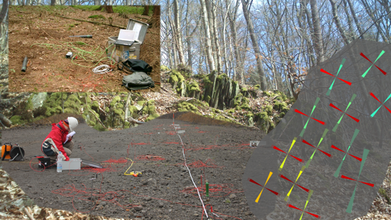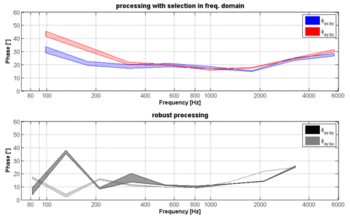
Study of an electrical resistivity anisotropy in the Westerwald, Germany
Isotropic 3D inversion models of electromagnetic data often contain high resistivity contrasts which cannot be explained by geological structures. The reason for these features could be anisotropic conductivity structures which cannot be modelled in inversion programs so far. The aim of this study is the proof of evidence for electrically anisotropic structures in the subsurface.
3D bipole-quadrupole resistivity measurements and the resulting apparent resistivity tensors could be a useful method to detect electrical anisotropy. The project contains modelling studies with COMSOL Mulitphysics to analyze the influence of anisotropic structures on the apparent resistivity tensor and on magnetotelluric phase tensors.

Additionally, a field experiment was performed in cooperation with the Leibniz-Institute for Applied Geophysics, Hannover, in June/July 2014. The large scale array was located in the northern part of the Westerwald area in Rhineland-Palatinate. This area is close to the river Sieg and part of the Rhenish Massif. The high resistive devonian bedrock is strongly foliated and disturbed by several faults and ore veins. The foliated sandstones and shales are supposed to cause an electrical anisotropy as the small cracks might be filled with fluids. Thirty dataloggers recorded the electric potential while an electrical current was injected with a high current source at 11 nearby positions and four stations in 2km and 5km distance using a rectangular function for the time dependence. Besides the potential measurements three audiomagnetotellurics (AMT) stations were set up which were also used for a controlled source MT (CSMT) study.
We developed a MATLAB code to calculate the apparent resistivities from the potential time series of the bipole-quadrupole measurements. The isotropic 3D inversion code BERT (Thomas Günther, www.resistivity.net) and 3D anisotropic COMSOL models are used to interpret the data.

The AMT time series were recorded with Metronix ADU07 dataloggers. The processing is difficult due to the high anthropogenic noise which ranges from individual peaks in the time domain to high periodic disturbances in frequency domain.To deal with this problem, we performed a lot of noise-studies and developed and testedsubsequently methods for reducing the influence of noise on the transfer functions. Additionally, to improve the results at lower frequencies,CSMT measurements were performed. Thus, artificial currents of different frequencies were injected into the ground to improve the signal/noise ratio and the transfer function values. The distances between the current injection and the area of observation varied between 1 and 7 km.
Publications:
Löwer, A., Günther, T., Junge, A., Grinat, M., Hering, P. (2014). Multi-method approach to analyze shallow anisotropic structures. Poster 22nd EMIW, Weimar, Germany.
Hering, P., Junge, A., Löwer, A., Löwer, A. (2014). Audiomagnetotelluric data analysis: elimination of high-frequency noise in AMT-time series. Poster 22nd EMIW, Weimar, Germany.
Löwer, A. and Junge, A. (2014). Influence of 3D anisotropic structures on bipole-quadrupole measurements. Extended Abstract 22nd EMIW, Weimar, Germany.
Rödder, A. and Junge, A. (2013). Einfluss dreidimensionaler anisotroper Strukturen auf Bipol-Quadrupol Geoelektrik und Audiomagnetotellurik Messungen. Extended Abstract 25th Schmucker-Weidelt-Colloquium on deep electromagnetic sounding, Kirchhundem Rahrbach, Germany.
Rödder, A. and Junge, A. (2013). Einfluss einer Abbruchkante auf den scheinbaren spezifischen Widerstandstensor. Poster DGG Jahrestagung, Leipzig, Germany.
Rödder, A. and Junge, A. (2012). Modelling of apparent resistivity tensors and Magnetotelluric phase tensors on anisotropic structures. Extended Abstract 21st EMIW, Darwin, Australia.



